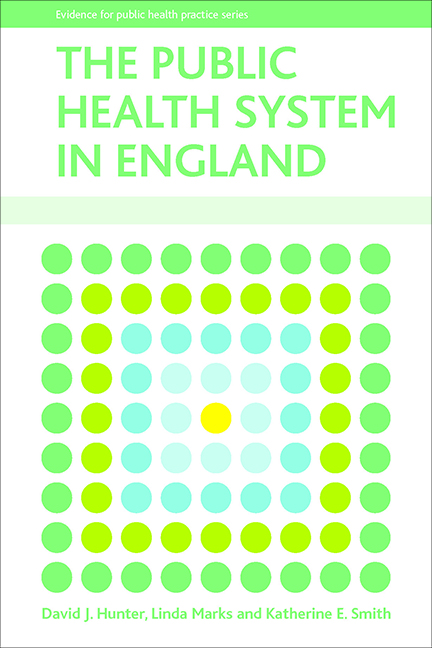Book contents
- Frontmatter
- Contents
- List of boxes and figures
- Acknowledgements
- List of acronyms
- About the authors
- one Introduction
- two Public health and a public health system
- three The evolution of the public health function in England (1): 1974–97
- four The evolution of the public health function in England (2): 1997–2009
- five Current issues in the public health system in England
- six Looking to the future
- Appendix: NHS reorganisation – 1975–2009
- References
- Index
four - The evolution of the public health function in England (2): 1997–2009
Published online by Cambridge University Press: 01 September 2022
- Frontmatter
- Contents
- List of boxes and figures
- Acknowledgements
- List of acronyms
- About the authors
- one Introduction
- two Public health and a public health system
- three The evolution of the public health function in England (1): 1974–97
- four The evolution of the public health function in England (2): 1997–2009
- five Current issues in the public health system in England
- six Looking to the future
- Appendix: NHS reorganisation – 1975–2009
- References
- Index
Summary
The election of the New Labour government in 1997 represented an important shift for public health, or so it seemed, as the party had made bold and ambitious commitments to tackling health inequalities and addressing the wider determinants of health in its election manifesto. A series of documents and debates stressing the need to give higher priority to the health of the public, to end the fragmentation of the public health function and to start seriously developing and strengthening its multidisciplinary nature subsequently emerged (Department of Health, 1998a, 1998b; Secretary of State for Health, 1999). The decade or so since 1997 has been a particularly active and fertile period for public health, although many of the issues at stake are familiar and have their antecedents in the period reviewed in Chapter Three. It has also been a somewhat chaotic and turbulent period, marked by numerous policy initiatives and structural changes, many of which appear to lack coherence. A number of these changes were not directed primarily at the public health function but their impacts have nevertheless been profound and are still being worked through. Some public health functions were relocated to arm's length bodies, a network of stand-alone organisations that include the National Institute for Health and Clinical Excellence (NICE) and the Health Protection Agency (HPA). Box 4.1 charts the changing organisational context for health protection.
Box 4.1: Health protection on the move
Health protection is largely concerned with infectious disease control, chemical and radiological hazards, emergency planning and the health care response to emergencies, including bioterrorism. In recent years, health protection has undergone significant change in respect of its organisation and location. The division of responsibilities for key public health functions was altered with the publication of Getting ahead of the curve (Department of Health, 2002), which created the HPA. This new agency, which was established to provide expertise on potential health threats such as infections and toxic hazards, took over much of the responsibility for public health protection. The creation of the HPA was the culmination of a number of changes in the nature and location of the health protection workforce starting in the mid-1970s.
- Type
- Chapter
- Information
- The Public Health System in England , pp. 63 - 102Publisher: Bristol University PressPrint publication year: 2010

